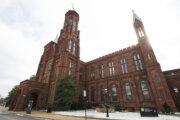WASHINGTON — It has been a tough news week in the DMV. Senseless acts of violence have deprived us of two quality human beings — one an innocent teenager just sitting with his mother and sister, the other an exemplary Virginia State Trooper participating in a training exercise. With a heavy heart due to events like these, I find solace in the sky and the stars — and I hope you can too.
This April, the worldwide organization Astronomers Without Borders (AWB) is launching its annual Global Astronomy Month.
From AWB:
Global Astronomy Month 2016 (#GAM2016) fills the entire month of April again with exciting programs for astronomy enthusiasts worldwide. Whether it’s stargazing, sharing with the public, or the cosmos in art, there is something for everyone in GAM 2016. Global Astronomy Month organized each April by Astronomers Without Borders, is the world’s largest annual global celebration of astronomy. Each GAM brings new ideas and new opportunities, and GAM 2016 is no exception, once again bringing enthusiasts together worldwide to celebrate Astronomers Without Borders’ motto ‘One People, One Sky’.
See AWB’s promo trailer below:
In the spirit of GAM, I will be starting my third season of “Let’s Talk About Space at Shenandoah National Park” Sunday, April 3 and hope to see you there during the season.
This week the National Academies Science Division held its annual Space Science Week at its D.C. headquarters. Luminaries from across the country in space science met in the following committees:
- Committee on Astronomy and Astrophysics (CAA)
- Committee on Earth Science and Applications from Space (CESAS)
- Committee on Astrobiology and Planetary Science (CAPS)
- Committee on Solar and Space Physics (CSSP)
- Committee on Biological and Physical Sciences in Space (CBPSS)
Each year during Space Sciences Week a public lecture is held and this year it was given by Alan Stern, the principal investigator for the New Horizons mission to Pluto, which is controlled by our very own Johns Hopkins Applied Physics Laboratory.
Stern’s lecture attracted quite a large crowd including young adults and children. The highlight for me, besides getting to meet Stern, was finding out that his favorite photograph of the Pluto flyby was the backlit portrait of Pluto showing its blue atmosphere. He said it was his favorite because “it proves that we were there.”
The other highlight was seeing the young attendees clamoring for autographs and pictures with Stern. To see such an accomplished scientist taking the time to sign autographs and pose with each and every single person — including me — well after his lecture had ended speaks volumes to his character. I’d like to think that Stern will be the catalyst that propels some of these admirers into science.
With the return of data from last year’s flyby at the halfway point, Pluto will no doubt continue to amaze us. And if NASA approves the funding, the New Horizons spacecraft will conduct a flyby of Kuiper Belt Object 2014 MU 69 in January 2019 — a billion miles beyond Pluto.
You can see Stern’s lecture here.
Next Friday, I will give you information on how to see Mercury, Mars, Jupiter and Saturn in what promises to be a very busy month of skywatching.
Follow my daily blog to keep up with the latest news in astronomy and space exploration. You can email me at skyguyinva@gmail.com.







